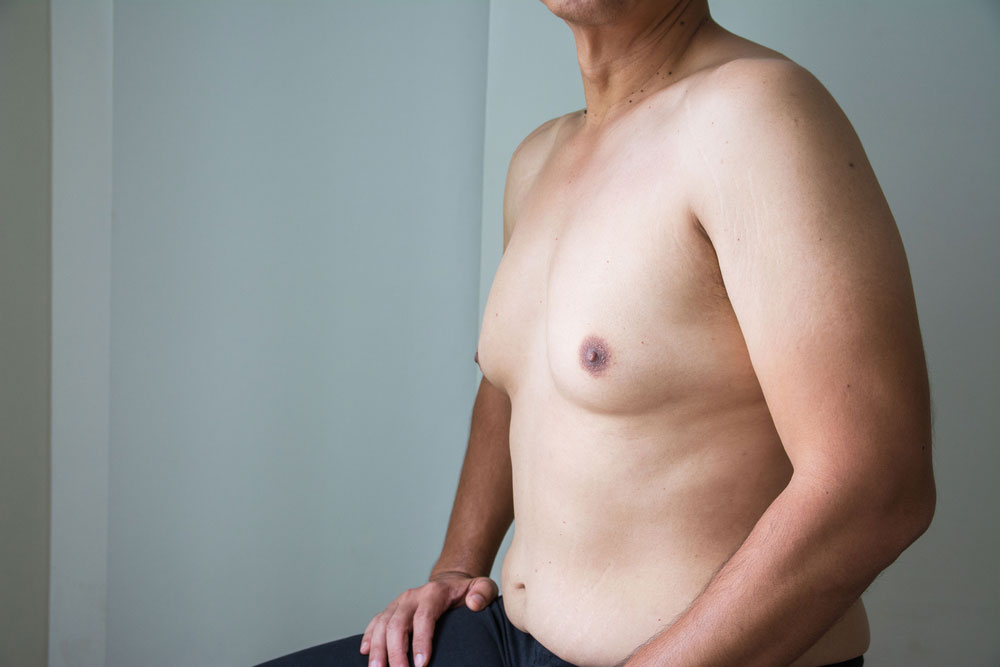How to Deal With Gynecomastia?

What a lot of people don’t know is that men who suffer from this condition have their lives turned upside down. They’re not able to enjoy many things that most of us take for granted, whether it’s having fun on the beach shirtless, getting to wear the latest trends in men’s fashion, or even being intimate with their loved ones. Men who suffer from Gynecomastia often also suffer psychologically, as the condition certainly affects their self-esteem on a deeper level. So how can men deal with this condition?
A Brief About Gynecomastia

“Man boobs” is the rough description of a condition scientifically known as Gynecomastia. Usually affecting boys in their adolescence or men in their late 50’s, Gynecomastia results in abnormal growth of their breasts. This happens because the breasts are fill up with fat and as a result, breast tissues develop. In many cases of Gynecomastia, they may even start secreting milk.
True gynecomastia can be confused with pseudo-gynecomastia. It’s more than just the sagging of fatty breasts like pseudo-gynecomastia is. It’s the development of breast tissues like those present in women. When breast tissues develop, affected men can find their nipples secreting milk-like substances, which do not happen with pseudo-gynecomastia. It also indicates disturbances in the female hormonal levels in men, namely the estrogen levels.
There is more than one cause for gynecomastia, whether in adolescents, old men, or even healthy adults. Usually, the condition doesn’t pose any threats to the physical health of the man, and there are some ways to deal with and treat gynecomastia. Learning how to make some lifestyle changes can be useful, such as diet and exercise. There are also surgical ways to intervene, but non-surgical interventions to get rid of gynecomastia like CoolSculpting are becoming more popular. This is because these non-invasive procedures offer many advantages over traditional surgeries; having almost no downtime, giving great results, and you won’t have to worry about having scars after surgery.
How Gynecomastia Affects Men’s Lives

There’s a lot of things to discuss when it comes to gynecomastia, but it’s one of the conditions that affected men don’t usually want to talk about. Raising awareness about it, offering them the freedom to talk about it, and share their feelings, along with giving them the options to deal with the condition can help them overcome all of their feelings of shame and lowered self-esteem.
Almost 2 in every 3 men are affected by gynecomastia, although it can be during different phases of their lives. When it hits adolescents, it usually resolves on its own in a few months or can take around three years as it may come along with puberty and then disappear as the boy’s body develops. However, with many cases, the issues follow these young men into adulthood if they don’t get it treated.
Men who suffer from Gynecomastia become extremely self-conscious, and who can blame them? It’s especially hard in a society that judges everyone based on their looks. Even more so, everything about the culture of this society frowns down upon men showing any kind of “weak” emotions. Being faced with shame about their lack of manliness with little or no space to express their feelings, they’re pushed into a corner where they feel helpless and unworthy.
It’s not only about being unable to enjoy their lives like every other young adult as if that wasn’t bad enough. They’re struggling with lowered self-esteem that makes it hard for them to put themselves out there to socialize and lead a normal life. This can go further beyond having a stable relationship with a partner, as the lack of self-esteem with no apparent help can result in episodes of panic attacks, anxiety, depression, and other psychological conditions that affect their productivity and take control of their lives.
Causes & Symptoms of Gynecomastia
Gynecomastia can occur for many reasons, some are more common than others.
1. Hormonal Imbalances
As we’ve mentioned earlier, the most common cause is hormonal imbalances. Everyone knows that testosterone is the primary male sex hormone, and estrogen is the primary female sex hormone, but it’s not as commonly known that men also have estrogen in their blood. The levels of estrogen in men are usually too little to cause any significant change, but when they get out of balance, these changes can be very noticeable. An increase in the level of estrogen is usually accompanied by decreased levels of testosterone. This results in decreased libido, sometimes shrunken testicles, problems ejaculating, and an increase in body fat.
2. Age
If we’re talking about common occurrences of gynecomastia, then it’s during infancy, adolescence, and aging.
Many baby boys are born with an excess of fat around their breasts, but it always goes away. When adolescents go through the phase of hormonal changes, the balance between their testosterone and estrogen can also be lost, if only for a brief time. Usually, it goes away in a matter of six months to two years.
As men age and get into their late fifties, this balance is tested once more. As their testosterone levels fall, their bodies can be more prone to the effects of estrogen. They start to lose their muscle mass, gain body fat, and increased levels of estrogen can eventually result in Gynecomastia.
3. Certain Medications
Hormonal imbalance and age can be natural causes for gynecomastia that most men are prone to experience, but other causes can trigger it unnaturally.
Such is the case with certain medications, such as:
- Chemotherapy
- Steroids
- Calcium Channel Blockers for the treatment of heart conditions
- Anti-androgens treating Prostate Cancer
- Anxiolytics such as Diazepam
- Some anti-depression medications
- Some antibiotics
- Some AIDS medications.
4. Illegal Drugs and Alcohol Abuse
Gynecomastia can also develop as a result of going down a road of illegal drug use. You’re probably familiar with the stories of all of those athletes who were misusing anabolic steroids to gain strength and muscle mass, albeit short-lived. One of the very serious side effects of anabolic steroids is destroying the body later on in many ways, one of which is developing Gynecomastia. Alcohol abuse has also been shown to increase levels of estrogen and gradually resulting in gynecomastia. Other illegal drugs that can also be culprits are marijuana, amphetamines, heroin, and methadone.
5. Health Conditions
In rare cases, gynecomastia can be the result of a hereditary condition known as Klinefelter’s syndrome. This condition results in hypogonadism, which is the inability of the body to produce normal levels of testosterone, which leaves the effects of estrogen more prominent. Other developed health conditions that result in gynecomastia are:
- Hyperthyroidism, or an excess of the Thyroid hormone production
- Liver Failure
- Kidney Failure
- Tumors
- Malnutrition
The one thing all of these conditions have in common is that they all throw the body out of hormonal balance.
6. Herbs High in Estrogen
Herbs are great for our health, but some herbs are just better left for females. That’s the case with herbs high in phytoestrogen levels, as they, in turn, increase the estrogen levels in men. This is true in the case of tea tree, lavender, flax seeds, anise, and others. It’s best to avoid consuming these herbs in any form and maybe even stay away from products containing them just in case.
How to Deal with Gynecomastia
Dealing with gynecomastia can be quite challenging but you don’t have to go through it alone. Knowing your options can give you some peace of mind, and it’ll provide you with more than one course of action. Here are some of your options:
1. Change of Medication
If you’ve noticed symptoms of gynecomastia due to starting a new medication, then you must consult your physician right away. Your doctor can prescribe you a change of medication before the symptoms get worse, they can even prescribe you medications to help with the side effects.
2. Surgeries
When worse comes to worst, there’s always the option of surgically removing the mammary glands and the excess fats. To do that, there are two different surgeries available:
1. Mastectomy: which is the removal of the whole tissue of the mammary gland. In comparison to the old ways, mastectomy nowadays is done through making a small incision endoscopically. This only leaves a small scar behind, instead of fully opening the skin around the breasts.
2. Liposuction or laser fat removal: which is the procress of removing fat out of certain body areas. While this procedure isn’t preferred for overall body fat loss, it’s effective in removing persistent fats from the areas that showed little response to diet and exercise.
3. Non-surgical Interventions
For those who don’t fancy getting scalpels near their skin, there are some non-surgical ways to get rid of the excess body fat. One of the most popular methods is CoolSculpting, which freezes the fat cells and kills them. It takes more than one session to get the work done, but after the course is done, fat cells are gone for good. However, being consistent on healthy lifestyle habits is essential so no new fat can replace the old.
Over the years, some medications claimed to be able to treat gynecomastia. However, there’s little proof of their efficacy, as most of them weren’t FDA-approved to treat gynecomastia. Some of these medications are testosterone replacement therapy for those suffering from low T-levels, Clomiphene, Tamoxifen, and Danazol. Before taking any new medications, never forget to ask your doctor for consultation.
4. Lifestyle Changes

You’ve probably heard this a million times already, but diet and exercise are essential for every aspect of your life. While it won’t treat the mammary glands, it will help with losing excess fat and getting back some of your confidence. Try consulting a local dietician for a nutritional plan that fits your needs. Exercise doesn’t have to be long boring hours in the gym or running on the track until you run out of breath. There are smart ways for your hard work to show results fast. If you’ve tried it before but it didn’t work, don’t give up. Maybe you just haven’t found the diet and exercise plans that fit you.
And speaking of lifestyle changes, your bad habits are a great starting point. If you’ve fallen into the habit of using drugs or illegal substances, maybe it’s time to seriously think about staying clean. Don’t be scared or ashamed of contacting rehab centers, they can guide you in the right direction.
5. Talk it Out
Last but not least, you don’t have to be alone in facing whatever you’re going through. It might be scary, but always remember that the first step in overcoming your fear and feelings of insecurity is to talk it out with someone you trust. Letting those closest to you understand what you’re going through will you give the strength to accept yourself. After all, none of us is perfect. Everyone is struggling with their inner battles and insecurities. Finding a support group can also be healthy in knowing others are facing whatever you’re feeling. If it feels too difficult to open up about it, maybe you can consider going to an understanding therapist to help you sort out your feelings and thoughts.
Starting a New Life
With all of the pressure about the ideals of a perfect body, living with gynecomastia can be very difficult for men in this age. There are many causes for gynecomastia, the most common of which are hormonal imbalances and aging, and less common are health conditions and certain medications. While learning how to accept your circumstances and live with gynecomastia is a great first step for mental wellbeing, it doesn’t have to be your only option. Both surgical and non-surgical interventions can help you combat Gynecomastia. As complementary measures, dropping bad habits and starting a healthy lifestyle can also do you great.
